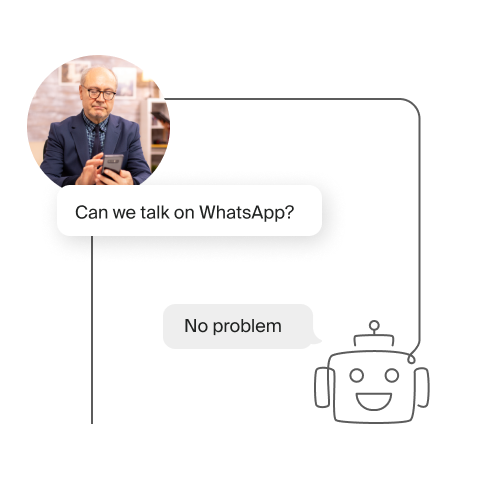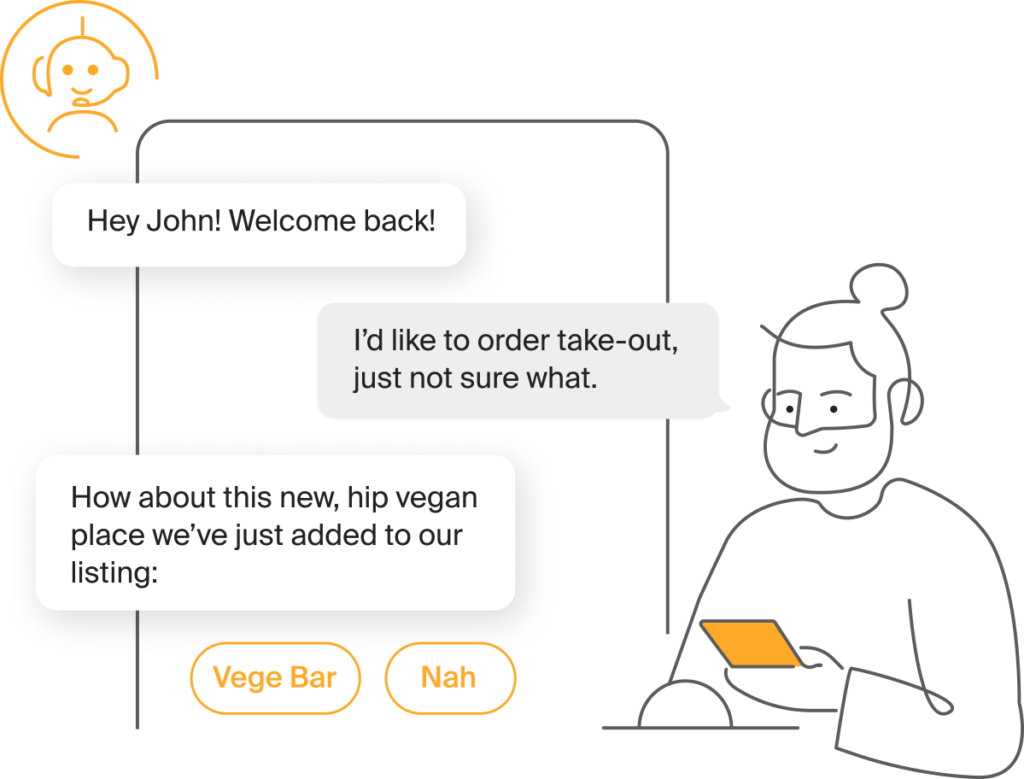71 % of business leaders said they plan to revamp the customer journey and 67% expect to spend more on AI chatbots over the next year. Promising a decrease in operational costs while helping increase in customer support agent productivity, AI Chatbots are a focus for a growing number of CSOs. In this article, we look at their overarching adoption goals, barriers to implementation and a step-by-step strategy to get the most from this technology.

3 Main Adoption Goals
A successful AI chatbot adoption requires meeting three overarching adoption goals:
- Getting buy-in from your entire organisation
- Wrapping the AI chatbot into all the workflows that come under its particular use case
- Embracing the transformative power of AI chatbots to benefit from increased operational efficiencies and enhanced Customer Experience (CX)
6 Types of AI Chatbots
In terms of uses cases, AI Chatbots for Customer Care can be grouped into 6 broad categories based on their functionality:
- Informational AI chatbots provide customers with instant access to general FAQs like store or bank opening times and high-level details about an organisations’ products and services.
- Customer Support AI chatbots can troubleshoot a range of common customer issues, freeing up live agents to answer more complex or emotionally sensitive queries.
- Promotional AI chatbots are used in sales and marketing for personalised product and service recommendations, cross-selling and upselling and offering loyalty discounts.
- Transactional AI chatbots enable users to complete and track specific tasks such as bank account transactions, making a restaurant reservation, or eCommerce shipping, delivery, returns, and refunds.
- Navigational AI chatbots streamline website customer journeys and lead your customer to the information they need so they have a better user experience (UX) and convert more quickly.
- Advisory AI chatbots can be programmed to offer expert advice and recommendations based on specific customer triggers and again transfer to a live expert where the need arises.

8 Use Cases for AI Chatbots in Customer Care
As one of the busiest enterprise departments, Customer Care can use AI Chatbots for a vide variety of processes and workflows. Some of the most important include:
- Providing real-time responses to FAQs
- Helping customers navigate the website or the app
- Deliver transactional notifications on orders, shipping, and returns
- Answer questions related to check-out and payments
- Direct customers to the nearest stores and pickup locations
- Manage appointments (scheduling and cancellation)
- Collect customer feedback through short survey and polls
- Automatically transfer to a live agent when needed
7 Potential Barriers to Adoption
The potential of AI Chatbots is becoming more widely recognised by CSOs, but many organisations hesitate to adopt them due to several common barriers.
1. Data Privacy and Security
CSOs must prioritize data privacy and security when adopting AI chatbots. Ensuring compliance with regulations, implementing robust security measures like encryption and secure storage protocols, as well as conducting regular audits are essential to build trust with customers.
2. Change Management and Workforce Adaptability
Resistance to change and lack of employee readiness can impede successful AI chatbot adoption. Customer support leaders should focus on change management strategies, training programs, and effective communication to help employees embrace and leverage the benefits of AI chatbots.
3. Customer Adoption
Gaining customer acceptance and delivering exceptional experiences through AI chatbots require careful design and optimisation. CSOs must prioritize user-centric design, implementation and adoption approaches, leveraging customer feedback and continuously enhancing the chatbot’s capabilities to meet evolving expectations.

4. Integration Complexity
Integrating AI chatbots with existing systems, databases, and channels can be complex, especially in organisations with diverse technology landscapes. CSOs should assess their infrastructure, prioritise seamless integration, and collaborate with technology partners to ensure a smooth transition. Proper integration enables more consistent data and more meaningful insights so you will be able to continuously upgrade your business operations, customer engagement, marketing, and sales strategies.
5. Cost Considerations
Budget constraints and cost projections can pose challenges for AI chatbot adoption. CXOs should carefully evaluate the costs associated with development, maintenance, training, and vendor partnerships, aligning them with the expected return on investment (ROI) and longer-term business goals.
6. Ethical and Legal Matters
As AI chatbots interact with customers and handle sensitive information, ethical and legal considerations arise. CXOs should establish internal ethical guidelines, ensure transparency in chatbot interactions, and adhere to Regulations to maintain trust and compliance. By acknowledging these barriers and actively addressing them prior to creating an AI chatbot adoption strategy, organisations can unlock the potential of AI chatbots and drive significant business value.
8 Practical Steps for AI Chatbot Adoption
1. Plan Your AI Chatbot Adoption Strategy
When creating your AI chatbot adoption strategy, you need to map it to your specific business goals, and the customer pain points you’re aiming to overcome. At the same time, you need to tactically address the barriers to adoption particular to your organisation.
2. Choose the Right Platform
Adopting an AI chatbot requires careful consideration of the platform that best suits your business goals. A reliable platform should offer seamless integration with your existing systems, support multiple channels such as websites and messaging apps, and provide robust security features. By selecting the right platform, businesses can leverage the full potential of AI chatbots to deliver exceptional customer experiences and achieve operational efficiency.
3. Collaborate on Workflows
To ensure your AI chatbot workflows and rules are well defined, involve your key employee stakeholders, such as customer support leaders and customer success engineers. The idea is to enable seamless collaboration between your AI chatbots and your human agents. Establish clear escalation paths and data transfer for queries that require human intervention, ensuring a smooth transition from chatbot interactions to live agent support.
FURTHER READING: AI Chatbot to Live Agent Transfer: 5 Great Workflows you can Create
4. Train Your Teams
In 2022, IBM reported that 35% of organisations were training and reskilling employees to work with AI. This step is critical for widespread internal AI chatbot adoption. Train your customer support and IT teams to effectively collaborate with your AI chatbot. Educate your team on its capabilities, limitations as well as best practices for escalating and resolving customer issues.
5. Embrace Omnichannel Integration
To deliver a seamless CX, it’s essential to integrate AI chatbots across your customers’ favourite messaging apps, like WhatsApp Business Messages and Viber conversations, as well as social media platforms like Facebook Messenger. This omnichannel integration ensures continuity and reduces friction, enabling customers to move between channels and devices within a single purchase journey or take the entire journey on their preferred channel. It also allows your stakeholders to synchronize marketing efforts, sales support, customer service, and lead generation activities.
6. Integrate Technology Systems
Based on your specific business model and requirements, choose the relevant technology systems and databases to integrate with your conversational AI platform. This can include customer relationship management (CRM) systems, enterprise resource planning (ERP) solutions, or other proprietary software. This will facilitate the automation of data collection and insights, lead and query management, database management and instant information retrieval. This integration unlocks the full potential of your AI chatbot empowering personalised and contextualised interactions, streamlining processes, delivering an exceptional CX, and driving business growth.

7. Personalise Your Chatbot
Imbuing your AI chatbot with powerful personalisation capabilities will greatly improve the CX and drive customer adoption, helping to achieve goals like reducing the number of support calls that require a live agent. This in turn improves internal adoption because your employees are more inclined to adopt a technology that genuinely helps them do their jobs.
In addition to this, you should also customise your chatbot to align with your brand’s tone and style. Incorporate personalisation elements to enhance user engagement and create a more human-like experience. Map the AI chatbot’s capabilities to known challenges for each of your ideal customer persona (ICP) problems and take into account that some customers will be tech savvy and keen to use a chatbot, whilst others will be sceptical and nervous. Once customers realise that the chatbot is able to recall their past behaviour data, make relevant recommendations, and provide personalised offers, they will be more inclined to adopt it.
8. Analyse and Measure Success
AI chatbot adoption is an ongoing process. Collect and regularly review customer feedback and analyse metrics such as response time and task completion rates to identify areas that require improvement. You can either manage improvement internally or in collaboration with your AI chatbot vendor. Either way you will need to refine the AI chatbot’s responses, expand its knowledge base, and enhance its conversational abilities to continuously improve performance.
Final Thoughts
When adopting an AI chatbot, it is crucial to carefully map the challenges you wish to overcome and select the right platform that aligns with your business goals. Platforms that offer seamless integration, support multiple channels, and prioritise data security offer the most flexibility and help you to overcome the most common challenges to adoption. Practical considerations, like personalising interactions, carefully developing workflows, and analysing performance metrics, are key to achieving the desired outcomes from your AI chatbot and ensuring widespread and ongoing adoption. Furthermore, continuous improvement, collaboration with vendors, and training your team will enable you to maximise the AI chatbot’s potential and deliver an exceptional CX.


